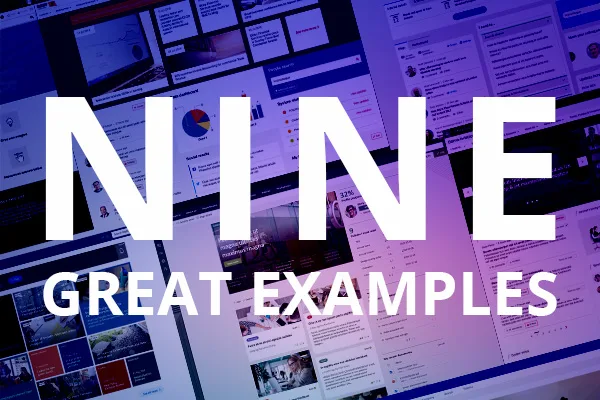
Valo intranet end of life? Lightspeed365 is your alternative
Facing Valo intranet’s end of life? Lightspeed365 is the future-proof SharePoint intranet alternative with seamless migration and top feature

Facing Valo intranet’s end of life? Lightspeed365 is the future-proof SharePoint intranet alternative with seamless migration and top feature

Intranet homepages are important. To achieve a truly successful intranet that keeps users on the site and engaged, in addition to serving information in an intuitive and user-centric way, both design and user experience (UX) elements must come together seamlessly.

There are a number of options when choosing an intranet platform. We think these options will begin to reduce as SharePoint is clearly emerging as the no-brainer choice, especially if you are using Office 365. Find out why a SharePoint intranet deserves the top position in your intranet shortlist.

If your organisation is using Microsoft 365 or SharePoint on-premises, then it makes sense to leverage the power of SharePoint to help better manage your policy documents.

Employee onboarding is a key process in employee experience, and can make a tangible contribution to talent retention. SharePoint is a strong foundational technology to design onboarding experiences and deliver related content and features.

Create an effective knowledge management strategy in 8 steps to align efforts, optimise sharing, and boost organisational success

In this article we give an overview of PowerApps and its possibilities, and how you can use it in your business.

We will look at some of the processes you can automate using Office 365, based on what we’ve seen with clients and other organisations.

What is the best way to manage an intranet? What are some of the intranet best practices that we should follow? These are typical questions that we get asked during an intranet project. Of course, there is no right or wrong or even definitive answer as every intranet and organisation is slightly different. However, over the years we’ve seen a LOT of successful intranet projects and there are a range of common approaches, techniques, tactics that work well time and time again. In this post we’re going to explore fifteen essential intranet best practices that will help to drive adoption and value on your intranet. Of course, some best practices will be more relevant to particular intranet teams than others. You might also not agree with us, and we can’t absolutely guarantee that an intranet best practice will work for you. However, we’re pretty confident that if you follow all fifteen of these suggestions that you’ll have a successful site. Let’s explore 15 essential intranet best practices. 1. Always have an intranet strategy based on user research An intranet delivers benefits at multiple levels across your organisation. It supports communications, delivers change management, drives productivity, underpins learning and knowledge sharing, improves processes, minimises risk and more. It’s a strategic-level benefit and it is important to get it right. It’s imperative to have an intranet strategy that will help to drive value and adoption. Having a well-thought-through overview of what you are trying to achieve with your intranet that aligns with your overall company strategy is essential. Having an accompanying plan and roadmap of how you’re going to achieve it also allows you to maintain focus, prioritise efforts, win over stakeholders, unite different team members around the same goals and ensure your intranet keeps moving in a strategic direction. An intranet strategy will also provide the framework for much of the detail around design, features, content and more. A successful intranet strategy must focus on the needs of users and be wrapped around the way they work. This can only be achieved with a thorough understanding of your employees, their respective needs and their pain points. Undertaking user research and discovery exercise to fully understand the needs of different groups is key. You cannot formulate an intranet strategy and build an effective solution based on assumptions. I f you’re going act on only one intranet best practice from this article, then this is probably the most important! 2. Involve cross-functional stakeholders from across the organisation Intranets impact an entire organisation and also need input from a wide variety of different business functions and departments. Creating an intranet and ensuring it remains valuable and has good adoption, requires input and ongoing involvement from a range of stakeholders including HR, IT, Internal Comms, Business Operations, and more. These cross-functional stakeholders not only provide critical feedback into the direction of your intranet but will also be responsible for important content and possibly some of the systems that you may want to integrate into your intranet experience. Stakeholder involvement should usually be reflected in some kind of ongoing governance structure such as representation on an intranet steering committee or as part of an intranet working group. When different stakeholders from varying functions are continually involved in your intranet, it has more buy-in, relevance and value. 3. Focus on content governance An intranet is only as good as the content published within it. Great content is purposeful, relevant, accurate, up to date, engaging and on-brand. Intranets often launch with content that has been refreshed so it ticks all these boxes, but then that content quality is not maintained, and the intranet starts to decline in value over time. A key intranet best practice is to ensure that you have a content governance framework in place that will help to maintain the quality of your intranet content over time. This is particularly important if you work with a devolved publishing model with content owners and authors from right across your organisation. A content governance framework will consist of a number of different elements including: Clear ownership of content, down to the page level. A set of clear publishing standards. Having clear content owner training, guidance and support. Providing site and page templates. Having regular reviews of content. Using automated reminders for page owners to review their content. 4. Ensure your users shape your intranet The best intranets are often shaped by direct input from the users. Involving users through research, iteration and testing when creating your intranet will help to ensure it is user-centric, and also gives your intranet more legitimacy in the eyes of employees. Another intranet best practice is to gather and act upon employee feedback regularly to inform changes. This not only provides hugely valuable data so you can tweak and improve your intranet, but it also lets employees know that their opinions are valued, emphasising the role of the intranet as a truly user-centric channel. There are various techniques to support gathering feedback, including creating a regular user group, running polls and surveys, and creating feedback mechanisms via the intranet itself. 5. Leverage digital and intranet champions for launch Invariably central intranet teams tend to be quite small, and sometimes can be just one-person or two-person teams. This can be challenging when launching an intranet across a large organisation. Many intranet teams find that leveraging a network of voluntary digital and intranet champions is an excellent way to launch an intranet and drive adoption. Champions provide a local point of contact to let different teams know about the new intranet, answer any questions, relay any feedback and provide any support. They may also promote ongoing changes and potentially play some kind of coordinating role with content. Digital champions provide additional value by being trusted by their peers and also by providing context about the role of the intranet with reference to local working practices and needs. 6. Make your intranet the front door to the wider digital workplace A primary role of

Discover how user and stakeholder research drive intranet success through comprehensive discovery for impactful, user-centric solutions.
Book in a live demo with us to discuss your project and find out more about our services, solutions and how we can add value to your digital workplace. Simply fill out the form and pick a time and date in our calendar.
Alternatively, if you have a question and would like more information about Content Formula, please visit our contact us page.
We look forward to meeting you.